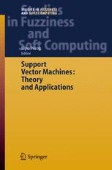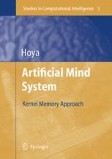Search
Search Results
-
Iterative Single Data Algorithm for Training Kernel Machines from Huge Data Sets: Theory and Performance
The chapter introduces the latest developments and results of Iterative Single Data Algorithm (ISDA) for solving large-scale support vector machines...
-
Support Vector Machines – An Introduction
This is a book about learning from empirical data (i.e., examples, samples, measurements, records, patterns or observations) by applying support...
-
Cancer Diagnosis and Protein Secondary Structure Prediction Using Support Vector Machines
In this chapter, we use support vector machines (SVMs) to deal with two bioinformatics problems, i.e., cancer diagnosis based on gene expression data...
-
Collision Free Motion Planning on Graphs
A topological theory initiated in [4,5] uses methods of algebraic topology to estimate numerically the character of instabilities arising in motion...
-
Coordinating Multiple Droplets in Planar Array Digital Microfluidics System
This paper presents an approach to coordinate the motions of droplets in digital microfluidic systems used for biochemical analysis. A digital...
-
Multi View and Multi Scale Image Based Visual Servo For Micromanipulation
In this article, we present vision-based techniques for solving some of the problems of micromanipulation. Manipulation and assembly at the micro...
-
From Classical Connectionist Models to Probabilistic/Generalised Regression Neural Networks (PNNs/GRNNs)
This chapter begins by briefly summarising some of the well-known classical connectionist/artificial neural network models such as multi-layered...
-
Sequential Pattern Mining*
Sequential pattern discovery has emerged as an important research topic in knowledge discovery and data mining with broad applications. Previous...
-
Discovering the Factors Affecting the Location Selection of FDI in China*
Since the late 1970s, Foreign Direct Investment (FDI) has played an important role in the economic development of China. However, the growth of FDI...
-
Data Mining and User Profiling for an E-Commerce System
Many companies are now develo** an online internet presence to sell or promote their products and services. The data generated by e-commerce sites...
-
Ontology-based Fuzzy Decision Agent and Its Application to Meeting Scheduling Support System
A Fuzzy Decision Agent (FDA) based on personal ontology for Meeting Scheduling Support System (MSSS) is proposed in this chapter. In this system,...
-
D-GridMST: Clustering Large Distributed Spatial Databases
In this paper, we will propose a novel distributable clustering algorithm, called Distributed-GridMST (D–GridMST for short), which deals with large...
-
A Probabilistic Approach to Mining Fuzzy Frequent Patterns
Deriving association rules is a typical task in data mining. The problem was originally defined for transactions of discrete items, but it was soon...
-
Data Mining of Missing Persons Data
This paper presents the results of analysis to evaluate the effectiveness of data mining techniques to predict the outcome for missing persons cases....
-
6 Beamforming Combined with Multi-channel Acoustic Echo Cancellation
For audio signal acquisition, beamforming microphone arrays can be efficiently used for enhancing a desired signal while suppressing...
-
4 Optimum Beamforming for Wideband Non-stationary Signals
Array processing techniques strive for extraction of maximum information from a propagating wave field using groups of sensors, which are located at...
-
Linkage Learning Genetic Algorithm
In order to handle linkage evolution and to tackle the ordering problem, Harik [47] took Holland’s call [53] for the evolution of tight linkage quite...
-
Preliminaries: Assumptions and the Test Problem
After introducing the background and motivation of the linkage learning genetic algorithm, we will start to improve and understand the linkage...
-
Modeling of Fuzzy Data
Fuzzy data are imprecise data obtained from measurements, perception or by interviewing people. Typically, those data are expressed in linguistic...
-
Data Driven Fuzzy Modelling with Neural Networks
Extraction of models for complex systems from numerical data of behavior is studied. In particular, systems representable as sets of fuzzy if-then...
